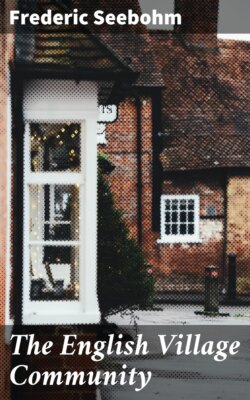Читать книгу The English Village Community - Frederic Seebohm - Страница 15
На сайте Литреса книга снята с продажи.
III. THE HUNDRED ROLLS OF EDWARD I., EMBRACING FIVE MIDLAND COUNTIES.
ОглавлениеTable of Contents
The facts thus learned from the Winslow Manor Rolls throw just that flash of light upon the otherwise dry details of the Hundred Rolls of Edward I. which is needful to make the picture they give in detail of the manors in parts of five midland counties vivid and clear.
Surveys of manors in five counties, A.D. 1279.
English economic history is rich in its materials; and of all the records of the economic condition of England, next to the Domesday Survey, the Hundred Rolls are the most important and remarkable. The second volume, in its 1,000 folio pages, contains inter alia a true and clear description of every manor in a large district, embracing portions of Oxfordshire, Berkshire, Bedfordshire, Huntingdonshire, and Cambridgeshire, in about the year 1279; and as in most cases the name of every tenant is recorded, with the character of his holding and a description of his payments and services, the picture of each manor has almost the detail and accuracy of a photograph. Turning over its pages, the mass of detail may at first appear confused and bewildering, and in one sense it is so, because [p033] it relates to a system which, however simple when fully at work, becomes broken up and entangled whilst in process of disintegration. But the key to it once mastered, the original features of the system may still be recognised. Even the broken pieces fall into their proper places, and the general economic outlines of the several manors stand out sharply and clearly marked.
They are of the Winslow type.
Speaking generally, in its chief economic features every manor is alike, as in the record itself one common form of survey serves for them all. Hence the Winslow example gives the requisite key to the whole. Bringing to the record the knowledge of how the open fields were everywhere divided into furlongs, and acre or half-acre strips, and that virgates and half-virgates were equal bundles of strips scattered all over the fields, the description of the manors in the Hundred Rolls becomes perfectly intelligible.
In the first place the manor consists, as in the Winslow example, of two parts—the land in demesne and the land in villenage.
The land in demesne consists of the home farm, and portions, irregular in area, let out from it to what are called free tenants (libere tenentes), some of them being nevertheless villeins holding their portions of the demesne lands in free tenure at certain rents in addition to their regular holdings.
Virgates and half-virgates.
The land in villenage, as in the Winslow manor, is held mostly in virgates and half-virgates, and below these cottiers hold smaller holdings, also in villenage.
In describing the tenants in villenage there is first a statement that A. B. holds a virgate in villenage at such and such payments and services, which are often [p034] very minutely described. The money value of each service and the total value of them all is in many cases also carefully given. This description of the holding and services of A. B. is then followed by a list of persons who also each hold a virgate at the same services as A. B.
Secondly, there is a similar statement in detail that C. D. holds a half-virgate in villenage, and that such and such are his payments and services, followed by a similar list of persons who also each hold a half-virgate at the same services as C. D.
Cottier tenants.
Then follows a list of the little cottier tenants, and their holdings and services. Amongst some of these cottage holdings there is equality, some are irregular, and some consist of a cottage and nothing else.
These holdings are all in villenage, but, as before mentioned, the names of the villein tenants often occur again in the list of free tenants (libere tenentes) of portions of the lord's demesne or of recently reclaimed land (terra assarta).
This may be taken as a fair description of the common type of manor throughout the Hundred Rolls, with local variations.
